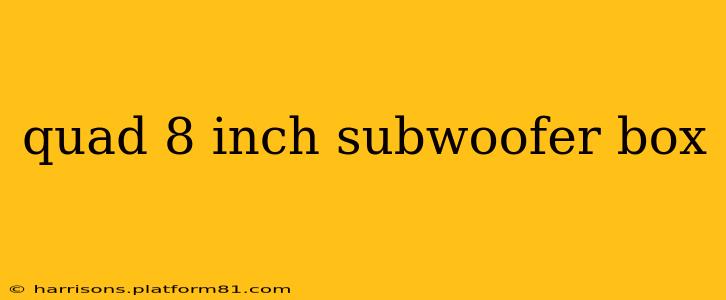Building a quad 8-inch subwoofer box requires careful planning and execution to achieve optimal sound quality. This guide explores the key considerations for designing, constructing, and tuning such a system, addressing common questions along the way. Understanding the nuances of subwoofer enclosure design is crucial for maximizing bass response and minimizing unwanted distortion.
What Size Box Do I Need for Four 8-Inch Subwoofers?
The ideal box size for four 8-inch subwoofers isn't a single number. It depends heavily on the specific subwoofer's specifications, particularly its recommended enclosure type (sealed, ported, or bandpass) and tuning frequency (for ported and bandpass enclosures). Most manufacturers provide these specifications in their subwoofer's documentation. Failing to match the box volume and design to these specifications can result in poor bass response, reduced efficiency, and even damage to the subwoofers.
You'll need to consult the subwoofer's specifications to determine the appropriate volume for each subwoofer individually. Since you're building a quad box, you'll likely need to consider several options:
- Individual Enclosures: Four separate enclosures, each tailored to a single 8-inch subwoofer. This provides the most accurate and controlled sound but takes up more space.
- Dual 2-Subwoofer Enclosures: Two enclosures, each housing two subwoofers. This balances space efficiency with individual optimization, though crossover and wiring complexities increase.
- Single Quad Enclosure: One large enclosure for all four subwoofers. This is the most space-efficient but presents significant challenges in achieving optimal performance for all four drivers due to potential acoustic interference. Designing a properly functioning single quad enclosure is often very difficult and requires advanced knowledge of subwoofer enclosure design.
What Type of Enclosure is Best for Four 8-Inch Subwoofers?
The best enclosure type – sealed, ported, or bandpass – again depends entirely on your subwoofer's specifications and your desired sound characteristics.
-
Sealed: Sealed enclosures are simple to build, offer a tight and accurate bass response, and are less prone to distortion. However, they generally have lower output than ported designs at lower frequencies.
-
Ported (Bass Reflex): Ported enclosures use a port (tube) to enhance low-frequency output. They generally offer higher output than sealed enclosures but require precise tuning to avoid unwanted resonances and distortion.
-
Bandpass: Bandpass enclosures are complex, requiring two chambers and carefully chosen tuning frequencies. They offer extremely high output in a narrow frequency range but are more challenging to design and build correctly.
How Do I Calculate the Cubic Feet for My 8-Inch Subwoofer Box?
Calculating the cubic feet (cu ft) is critical. Use the manufacturer's specified volume as your starting point. Remember that the internal volume is what matters – you must account for the thickness of the wood when calculating the external dimensions. There are many online calculators available that can assist you with this calculation, simply inputting the internal dimensions (length, width, height) in inches.
What Wood is Best for a Subwoofer Box?
Medium-density fiberboard (MDF) is the most popular choice for subwoofer boxes due to its density, rigidity, and ability to dampen vibrations. Avoid particleboard, as it's less rigid and more prone to resonance. The thickness of the MDF is also important; thicker is generally better for minimizing resonance, but it increases weight and construction complexity.
How Much Power Can a Quad 8-Inch Subwoofer Box Handle?
The power handling capability of your quad 8-inch subwoofer box is determined by the lowest power handling capacity of the individual subwoofers. Don't exceed this rating; doing so risks damaging your subwoofers. Always ensure your amplifier's power output doesn't surpass the combined safe operating power of your subwoofers.
What Kind of Ports Do I Need for a Ported Box?
If designing a ported enclosure, the port's dimensions (length, diameter) significantly affect tuning frequency. Using a port design calculator and referencing the subwoofer specifications will accurately determine the correct dimensions. You can use PVC pipe, pre-made ports, or even cut the port from the same MDF as the box itself.
In conclusion, building a quad 8-inch subwoofer box is a rewarding project, but it requires careful planning and attention to detail. Always prioritize accurate measurements and calculations, consult your subwoofer's specifications, and don't hesitate to utilize online resources and calculators to aid in your design process. Remember, precision is key to achieving optimal sound quality and maximizing the potential of your subwoofer system.
